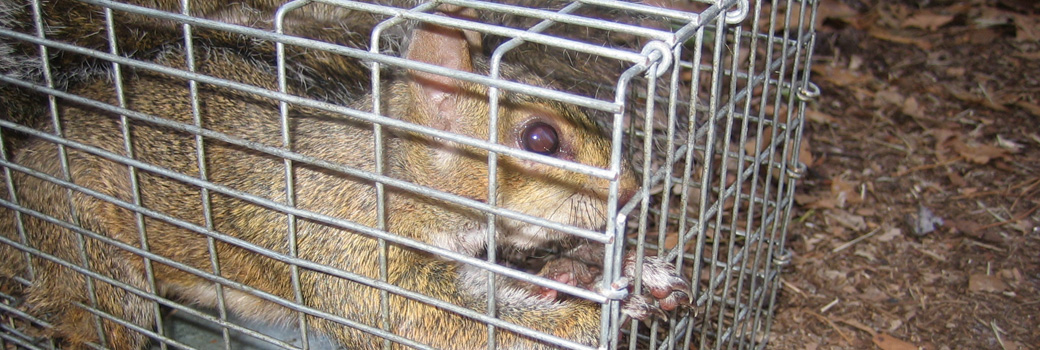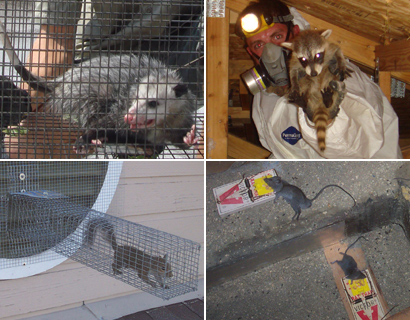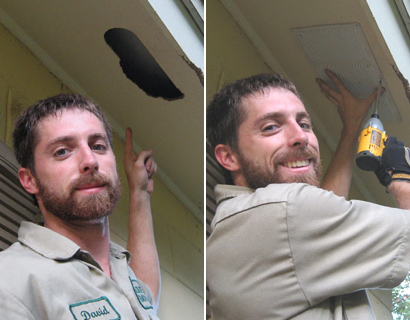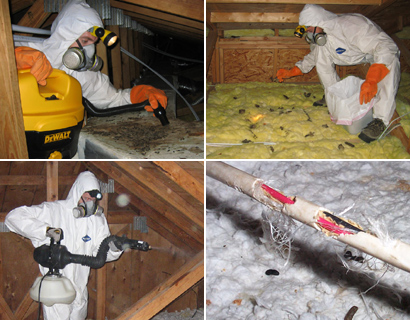- How We Solve California Wildlife Problems
How We Solve San Jose Wildlife Problems
INSPECTION: Once on site, we will perform a full inspection of your home and property. This allows us to use the correct strategy and traps. If the animals are in an attic, a full building inspection is crucial, including the following:
- All ground-level areas, such as piper or A/C line entry & exit areas, A/C chase bottoms, ground-level vents, etc.
- All mid-level areas, such as dryer vents, siding gaps, first floor eaves or dormers, etc.
- We inspect the entire roof, including all plumbing stacks, ridge caps, vents, and other potential gaps or holes.
- We also inspect inside your attic, to identify animals and damage they have caused.
- If the animals are outside, we notice many subtle clues that will assist us in a successful strategy.
TRAPPING, EXCLUSION, REMOVAL: Once we understand what animal species we are dealing with, and the problem, we use the most effective means of removing the animals. We use dozens of different types of traps.
- Trapping - If trapping the animal(s) in live cage traps, trap type, set, and location are crucial to success.
- Exclusion - Oftentimes, we are able to simply set one-way doors or other exclusion devices that allow the animals inside a building to safely exit, but never get back inside.
- Removal By Hand - Sometimes we actually remove animals by hand, or with special tools like snare poles.
- The Law - In all cases, we obey state and local laws regarding wildlife, but aim to take the most humane approach.
ENTRY HOLE REPAIRS: Repairs are a crucial step in the wildlife removal process. In many cases, such as bat or rodent control, the job cannot be performed without detailed repairs, and in all cases, sealing the entry holes shut ensures that no future wildlife will ever enter your home.
- 100% of the entry holes must be found, and sealed shut, or the job is not complete.
- Our repairs are professional contractor grade, look good, and when applicable we use steel, which rodents such as rats or squirrels are unable to chew through.
- We give a written guarantee on our repairs against any future animal entry.
ATTIC DECONTAMINATION SERVICES: It may be desirable to clean your attic after we've removed the animals. They can leave behind large amounts of droppings, urine, hair, oils, food, nesting material, and so on. These remnants can attract insects like cockroaches, and the scent left behind can encourage new animals to chew their way into your house. You might experience odor problems from the waste. It's possible that mold will grow on waste areas.
- We remove or vacuum all droppings, or remove all the soiled insulation.
- We fog the attic with a special enzyme-based cleaner that destroys any organic matter and deodorizes the space.
- We repair damage, such as ductwork, electrical wires, pipes, insulation, and more.
Here in San Jose, we have beautiful weather. So most of our residents keeps their windows and doors open when the weather permits. However, while you are occupied with something around your house, a wildlife critter such as a raccoon or a rodent may walk right into your home. Don't worry, we can fix that if it is happening to you! We specialize in trapping and removing California's wildlife that has ended up in your home or on your property. We answer our phones 24/7 to help with your wildlife problems! We service the following cities: Alameda, Albany, American Canyon, Antioch, Atherton, Belmont, Oakland, Oakley, Orinda, San Francisco, San Leandro, San Mateo, San Pablo, San Rafael, San Ramon, Santa Rosa, Sausalito, Sebastopol, Sonoma City, South San Francisco, Suisun City, Tiburon Town, Union City, Vacaville, Vallejo City, Walnut Creek, Windsorn Town, Woodside, Yountville, Las Gatos, Campbell, Cupertino, Santa Clara, Sunnyvale, Mountain View, Palo Alto, Milpitas, Fremont, Morgan Hill, Gilroy, and Saratoga. We also service the following counties: Contra Costa County, Del Norte County, El Dorado County, Fresno County, Lake County, Tehama County, Stanislaus County, Sutter County, Tuolumne County, Ventura County, Yolo County, and Yuba County.
Other San Jose animal pest control topics:
Killing a Caged Squirrel
What Diseases do Rats Carry
What if a Raccoon Got Inside My House?
What's a Bat’s Natural Habitat?
To learn more about our services, visit the San Jose wildlife control home page.
This month's wildlife how-to article: Finding the best bait to trap a squirrel
Finding the best bait to trap a squirrel
You have decided to alleviate your squirrel problem by trapping them. Now you need to find the right bait for your trap. Squirrels are omnivores by nature. They prefer nuts, seeds, soft fleshy fruits and veggies. Most experts recommend the following items to make your trap tempting: Apples, almonds, popcorn, orange slices, sunflower seeds, or peanut butter. When setting a trap for a squirrel it is best to bait it with things they normally eat. Where you are setting your trap is also important. Deciding where the trap goes affects what bait works best to catch your vermin. For example, if the squirrels pestering you are eating your garden plants or tree crops, you might decide to put the trap in your garden.

Use something for bait that they are already going after in your yard. Bait your trap with a garden vegetable or nuts from your trees. Researchers have found that although a squirrel’s natural diet contains very little salt or refined sugar, like most humans, squirrels love it too! If you are putting the trap on your porch or deck where squirrels come to scavenge human’s leftovers, try using salty chips, roasted peanuts, sweetened cereal, or sugary snacks. When the brazen squirrel comes up for a handout you’ll have him! If you are attempting to catch a squirrel inside a building it is probably more thirsty than hungry. Orange or apple slices have a strong aroma and hold a lot of moisture. They will make the perfect bait for your attic or crawlspace. . The bait used in your trap should be placed correctly. Your bait must be able to coax the animal on to the trip plate, not be easily removed, and small enough that it cannot be reached from outside the cage. Because of these requirements it’s often best to mix your baits. Use sticky peanut butter or molasses on your trip plate because it is not easily removed. Now, using the sticky substance like glue, stick in nuts and seeds or fruit slices. The sticky base on the plate will hold the other bits securely. Perhaps you do not intend to relocate your squirrel after trapping it. There are many varieties of poison baits on the market.
All of them will come with extensive instructions and warnings and should be handled with extreme care. Poison bait is best used when you have no other options. Poison is not guaranteed to work on squirrels. Often it just makes them sick. You should also know that these dangerous chemicals are poisonous to humans and other animals as well. Using the right bait the right way can assure that your squirrel problem is over quickly.





